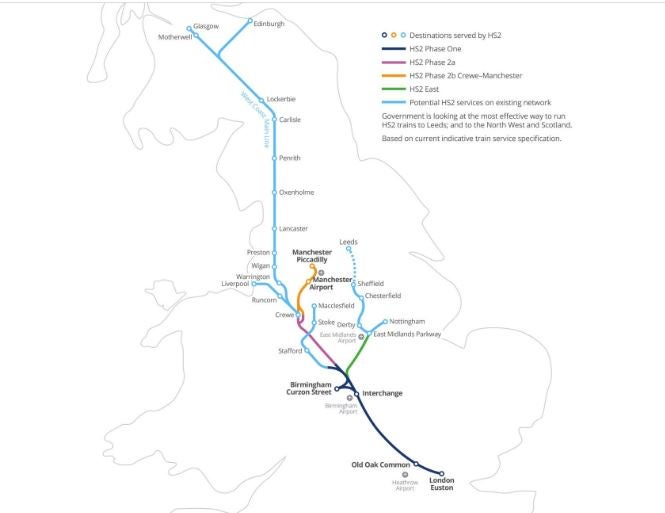What is HS2, where will it go and when will it be completed?
The government is rethinking plans for part of Britain’s biggest rail infrastructure project, much delayed and well over budget
After years of setbacks, controversy and spiralling costs, phase two of the long-awaited HS2 rail project appears to be under threat.
The Independent has exclusively revealed that prime minister Rishi Sunak is considering ditching plans for the leg from Birmingham to Manchester.
Britain’s largest infrastructure project had been scheduled initially to open in 2026, but the date of the London-to-Birmingham leg alone has been put off until 2029 to 2033 following technical difficulties and rising bills.

The total cost, estimated at around £33 billion in 2010, is now expected to reach £71 billion.
Below we look at everything you need to know about the troubled scheme, as questions about its future continue.
What is HS2 (and for that matter, what is HS1)?
High Speed 1 is the 68-mile fast railway line from London St Pancras to the Channel Tunnel at Folkestone in Kent, which opened in 2008.
High Speed 2 is a much more ambitious rail project, involving 345 miles of new high-speed track.
The first phase of this high-speed line will include stations at London Euston, Old Oak Common in west London, Birmingham Interchange and Birmingham Curzon Street. Work on this section, which will join the West Coast Mainline, is already underway.
Phase two is in two parts, 2a and 2b. In March, the government announced that work at Euston station in central London, as well as construction of the Birmingham to Crewe leg, would be delayed by two years to save money amid ballooning costs.
With services not stopping in Euston for years to come, passengers will instead have to travel for half an hour on the Elizabeth Line.

Why is it needed?
HS2 was designed to relieve pressure on the West Coast line and reduce journey times.
When the plan was first unveiled, the arguments were focused on cutting journey times. But the real reason is to provide much-needed extra capacity.
The existing West Coast main line is the busiest inter-city route in Europe, handling a mix of Avanti express services, commuter trains and freight. There is no room for expansion, and the system has little resilience.
How much faster will the journeys be?
Target times for HS2, compared with the fastest times for journeys today, include:
London-Birmingham: 45 minutes (81 minutes)
London-Manchester: 67 minutes (125 minutes)
Birmingham-Manchester: 40 minutes (87 minutes)
What is supposed to be happening with HS2 phase 2?

Phase 2a has long been planned to involve a line running from Lichfield in the West Midlands to Crewe, before services join up with the existing network so passengers can travel on to Liverpool, Manchester, Preston, Carlisle and Glasgow.
The law for phase 2a has received royal assent but the opening date for phase 2a has been pushed back from 2033 to between 2035 and 2041.
In May this year, a large sinkhole appeared above a tunnel being built for the line in Buckinghamshire. An HS2 spokesperson said the sinkhole was related to “existing ground conditions”.
Phase 2b, the western leg from Crewe to Manchester, is intended to serve new stations at Manchester airport and Manchester Piccadilly, with a link to the West Coast Main Line at Crewe for trains to Scotland.
A planned eastern leg from Birmingham to Leeds was scrapped in November 2021 as part of the Integrated Rail Plan for the North and Midlands, and will now stop at East Midlands Parkway. From there, services to Sheffield will run only on existing lines.
Phase 2b is awaiting parliamentary approval.
What are the concerns over the scheme?

The rethink follows the announcement last month from HS2 Ltd’s chief executive Mark Thurston that he was resigning amid major delays and cost pressures for the project. Two weeks later, an official watchdog rated HS2 “unachievable” for a host of reasons.
Both the first two phases were given a “red” flag by the Infrastructure and Projects Authority, which reports to the Cabinet Office and HM Treasury.
"Successful delivery of the project appears to be unachievable,” the authority warned. “There are major issues with project definition, schedule, budget, quality and/or benefits delivery, which at this stage do not appear to be manageable or resolvable. The project may need re-scoping and/or its overall viability reassessed."
At the time, a Department for Transport spokesman said: “Spades are already in the ground on HS2, with 350 construction sites, over £20 billion invested to date and supporting over 28,500 jobs.
“We remain committed to delivering HS2 in the most cost-effective way for taxpayers.”
Join our commenting forum
Join thought-provoking conversations, follow other Independent readers and see their replies
Comments


Bookmark popover
Removed from bookmarks